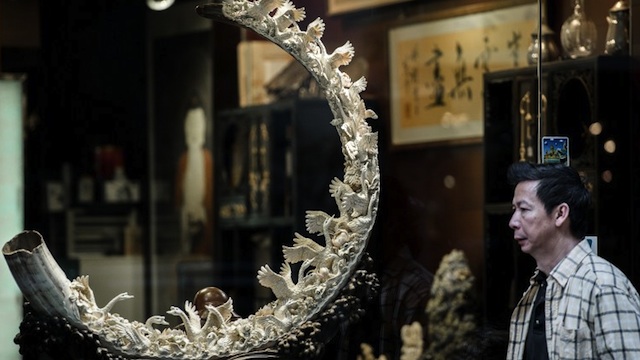SUMMARY
This is AI generated summarization, which may have errors. For context, always refer to the full article.

BEIJING, China – China crushed a pile of ivory reportedly weighing over six tons on Monday, January 6, in a landmark event aimed at shedding its image as a global hub for the illegal trade in African elephant tusks.
In what was described as the first ever public destruction of ivory in China, masked workers fed tusks from a pile surrounded by ivory carvings into crushing machines in the southern city of Dongguan.
The event was “the country’s latest effort to discourage illegal ivory trade, protect wildlife and raise public awareness”, the official news agency Xinhua said.
Surging demand for ivory in Asia is behind an ever-mounting death toll of African elephants, conservationists say, as authorities have failed to rein in international smuggling networks.
Experts believe that most illegal ivory is headed to China – where products made from the material have long been seen as status symbols – with some estimating the country accounts for as much as 70 percent of global demand.
Chinese forestry and customs officials oversaw the destruction, which was shown live by state broadcaster CCTV. It reported that the ivory weighed 6.1 tons and had been seized over a period of years.
Some of the crushed ivory powder would be disposed of, some would be displayed in a museum exhibit, while the rest would be “preserved”, state-run China National Radio reported. The substance can be used as an ingredient in traditional Chinese medicine.
China was in March named by the Convention on International Trade in Endangered Species (CITES) as one of eight nations failing to do enough to tackle the illegal trade in elephant ivory.
In July last year more than 1,000 ivory tusks, mainly from baby elephants and headed for mainland China, were seized by customs in the southern Chinese city of Hong Kong.
CITES banned international ivory trading in 1989, but the environmental group WWF estimates that around 22,000 elephants were hunted for their tusks in 2012, with a greater number projected for the following year. There could be as few as 470,000 left, it says.
Other countries have carried out similar exercises, with the US crushing six tons of ivory in November. The Philippines destroyed five tons of tusks in June, and Kenya set fire to a pile weighing the same amount in 2011. – Rappler.com
Add a comment
How does this make you feel?
There are no comments yet. Add your comment to start the conversation.